

 TERRY SMITH reveals his favourite class of locomotive.
TERRY SMITH reveals his favourite class of locomotive.
I'm often referred to here as the slot car guy, but you cannot work in a place like this and not be a railway enthusiast. When asked if I would write about my favourite class of locomotive, I said yes, as long as no one knows what it is until it is published! Consequently, the office has been guessing ever since. Will it be steam or diesel? "We know he likes the Southern region steam," one said, "Yeah the Q1, or possibly the Bullied Pacifics?" Both good choices, but no. "How about the W.R. Diesel Hydraulics?, I know he's mentioned the Class 52 Westerns a few times," said another. Yes, it's my favourite diesel, but not my favourite class overall - that goes to the Standard 9F.
I was just 4 years old when the last of the class 92220 Evening Star rolled out of Swindon Works in March 1960 as the last steam loco built for BR. She was the only one of her class to carry lined Brunswick green and be named, although it will be the 250 workaday black locomotives that the class will be best remembered. Designed by R.A. Riddles in 1951 at both Brighton and Derby works, the heavy freight locomotives first entered service with British Railways in 1954, having being built at either Crewe or Swindon. They soon got the nickname from train spotters as Spaceships as their size seem to be from another world!
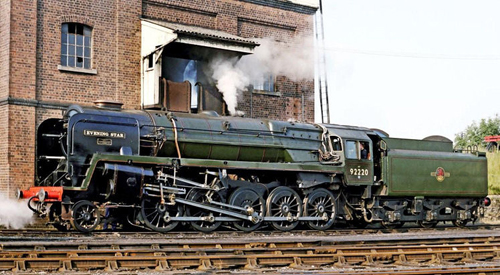
When introduced, the loco was equipped with a single chimney but later versions were equipped with a twin blast pipe double version which I personally feel befits such a powerful locomotive. Another variation of the class was the tender, and although there was apparently five different kinds that the loco pulled, the majority were either coupled to a BR1C High sided or the BR1G low sided version. Finally there was of course the Crosti boilered version, which to my eye totally ruined the handsome look of the loco, so that's all I going to say about it!
Although designed as a heavy goods loco, the class was often pressed into working passenger train duties, albeit only during the warmer months as they were not equipped for steam heating the coaches. They were seen on many Summer Specials hauling happy holiday makers to seaside destinations around the country, with one over-enthusiastic driver claiming he topped 90mph on one such excursion. When news of this reached the powers to be it was put out that such antics should be refrained from, as the smaller than normal driving wheels would be spinning at such high revolutions that it could possibly cause damage to the axle bearings!
It's most famous outings as a passenger pulling loco of course must be the time some of the class spent working the much lamented Somerset and Dorset line. Even Evening Star herself made appearances, and pulled the last Pines Express over the Mendip Hills in 1962. I never got to see the 9F in revenue service but am pleased to say that I have seen Evening Star on display at the NRM in York many moons ago, and even prior to that I did get a ride on David Shepherds 92203 Black Prince when she was at the East Somerset Railway during the late 1970s. I remember what a ridiculously large loco it was for such a short piece of track! Of note the Great Central Railway in Loughborough have repainted their 9F 92214 just this year to take on the identity of Evening Star and looks fabulous now as 92220. Finally, only last week on a business trip to the Bluebell Railway I spotted 92240 sitting outside Sheffield Park shed waiting for her turn for refurbishment.
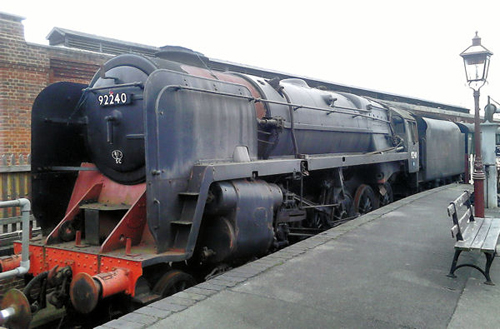
Modellers have been reasonably well served when it comes to this class of locomotive, with the OO plastic kit version from Rosebud Kitmaster being released first in the 1950s. This is same model that was sold as an Airfix kit from the 1960s and is still in the current range of kits from Dapol. We had to wait till 1972 before Tri-ang/Hornby released a 9F as a RTR loco and was tender driven powered by the then popular Ringfield motor.
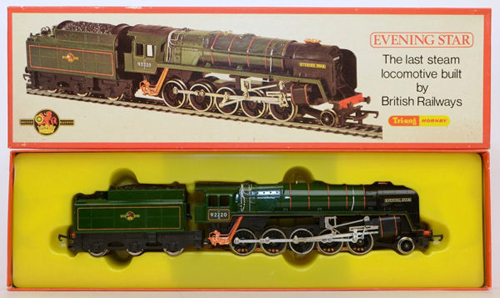
It was initially available as both Evening Star and as standard black version but it was the Green named model that appeared in nearly every catalogue since, right up to the new millennium. Just as Hornby were dropping this hugely popular, but now outdated model, Bachmann introduced their impressive loco driven version, not only with the more common single chimney but with either the BR1C or BR1G tenders. Another wonderful option from the guys from Barwell was that it was available in heavily weathered condition something that the real locos were seen more and more of as they ended their lives.
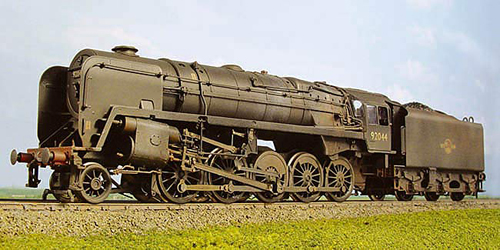
Since then Hornby re-engineered their own 9F converting it to loco drive and releasing it in their value for money Railroad range, as a Crosti Boiler 9F 2-10-0 92028 BR Heavily Weathered.
It was British Minitrix who flew the flag for the 9F in N gauge who based it on an existing German 2-10-0 Minitrix chassis. In most eyes the model introduced in the 60s just didn't look right, although it was available up to the early 1980s in either black or as Evening Star. Dapol then introduced their super detailed version around ten years ago and like the larger Bachmann model it is available with both chimney and common tender options.
Personally, while I do own both a OO Bachmann and Dapol N gauge version of the 9F, I also (some 30 odd) years ago picked up a new Hornby version of Evening Star for just £15 in a sale from a shop in Brighton. I was so disappointed with the unpainted green finish and the lack of basic handrails I decided to wreck my new purchase! Instead of removing the whole of the moulded hand rails with a sharp craft knife, I left a section of it where it crossed the boiler bands so there was something to mount the handrail wire to, which I did with a tiny blob of epoxy resin. No handrail knobs for this guy! I also sanded down the leading edge of the smoke deflectors and then the previously detached upper body of the loco and tender was sprayed with satin black spray and then the assembled model was slightly weathered.
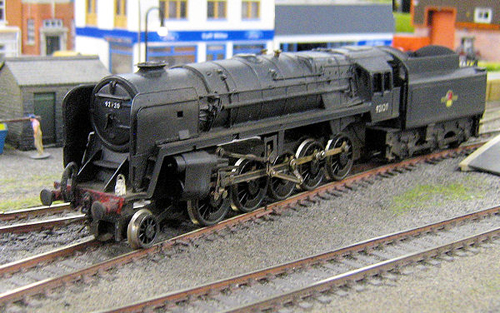
Late crest logos were added from a Pressfix sheet along with a change of number, one last thing I had to correct was the front steps that are attached to the front bogie. These were cut away from the casting with a razor saw, filed down in thickness and then stuck to the front of the loco. Unfortunately I have since lost the steps as my picture shows, but overall I was happy with the results of my own Spaceship conversion.
CLICK HERE to view the currently available 9F locomotives.